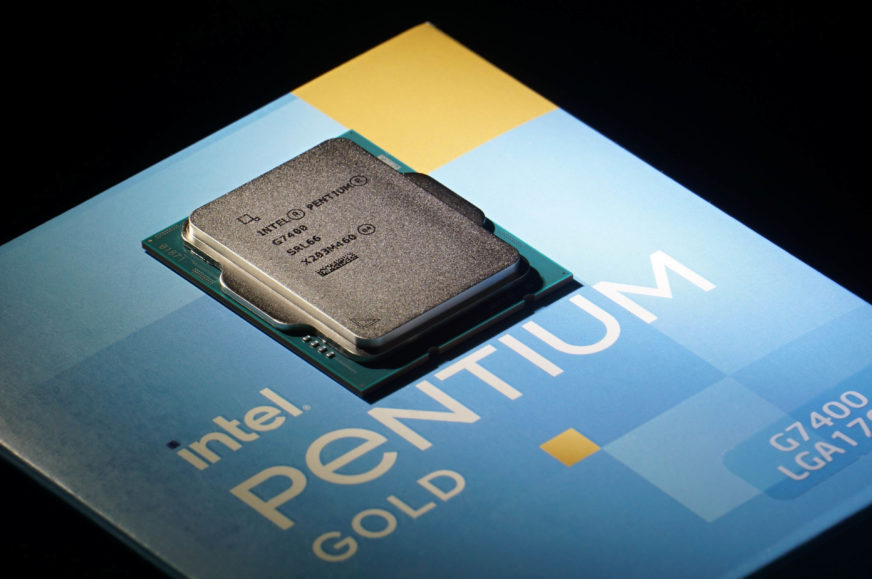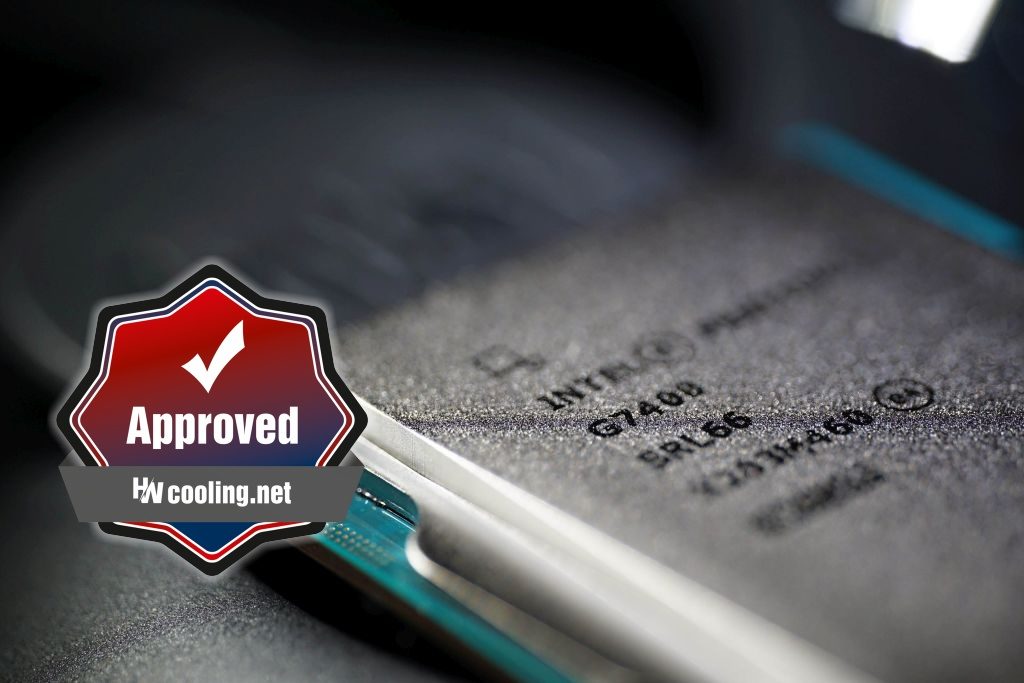Conclusion
From the top, we gradually worked our way down to the class of the iconic Pentium. Its design is quite conservative by today’s standards. The performance of the dual-core processor is at the limit, which begins to complicate the actual execution of the tests. One of the biggest appeals is the low power draw, but that may not be worth much if your processor can’t handle your demands in real time. Or can it?
Conclusion
Don’t expect too much performance from the Pentium G7400. It’s a simple, cheap and economical processor for undemanding use. Eventually, it may be a suitable base for a beginner user, for office, HTPC and just enough for kids’ setup to fulfill school duties, but also to do gaming (for a reward).
However, it should be noted that the drop in performance for is really rapid compared to the higher end (Core i3). At Full HD resolution, the Pentium G7400 trails the Core i3-12100(F) by up to 42 % on average, behind the Core i3-10105F, it’s 27 %. There is also a slightly smaller but still significant loss in 1440p resolution. It’s pointless to detail that it’s different in 2160p (and it’s only in single digit percentages). A Pentium with a 4K monitor within a gaming PC would be a very rare configuration. Most often this processor will function with 1080p resolution, but lower resolutions may be under consideration here. Especially when pairing with older graphics cards that also lack the performance, and resolution and details will be greatly reduced with them.
Of the games tested, the Pentium is most tortured by Cyberpunk 2077. Achieved fps are half compared to the second weakest processor – Core i3-10105F – in 720p. It’s not much better in 1080p either, where the Pentium has a 46 % disadvantage. There’s also a very big difference compared to more powerful processors in DOOM Eternal or in F1 2020. By contrast, the low CPU performance is reflected the least in Metro Exodus. Of course, you also have to take into account that applications running in the background skew performance significantly more than on multi-core processors. So don’t rely too heavily on the fact that you’re getting by as well as we did in our tests – the reality may be worse. We have a clean system for consistency of measurements, and there’s nothing special running in the background that takes performance away from gaming. In practice, however, it may be different.
Recording video during a game on a processor of this class sounds crazy, but paradoxically it doesn’t completely ruin the processor even with the x264 encoder. Understandably though, it’s nothing comfortable, and even when gaming fps stays above 60, the running is accompanied by microstuttering (minor tearing at frame rates), more than with more powerful processors. And for example, the Microsoft Flight Simulator indicates possible errors at launch due to not meeting minimum requirements. We didn’t see any bugs in our tests, and ironically, the smoothness is higher than it was with the Ryzen 9 5900X before the big update last July. But now, of course, the situation is different, and the framerate with the Pentium is two-thirds that of the Ryzen 9.
The Pentium G7400 is not a bad processor, but don’t expect miracles from it. In addition to its low purchase price, its great advantage is its low power draw.It’s around 40 W, below TDP levels (even with CPU Lite Load at maximum), while clock speeds are relatively high – 3.7 GHz according to Intel’s specs. Naturally, temperatures are also low, allowing the use of very small coolers, which comes in handy in atypical designs in the vertical market. For kiosk use, however, keep in mind that the iGPU resolution stops at 4096×2160 px despite HDMI 2.1 support.
TL;DR: The Intel Pentium G7400 is an attractive processor for simple, typically single-purpose computers. Cost effective, economical, and in all respects superior to the first generation Core i3s that still survive in some organizations.
English translation and edit by Jozef Dudáš
| Intel Pentium G7400 |
| + Relatively low price for a CPU with an iGPU |
| + Sufficient performance for light office use |
| + Decent performance in single-threaded applications |
| + Low power draw |
| + High efficiency (impressive performance per watt) |
| + Good performance per clock |
| + Modern 7 nm manufacturing process |
| + Very low temperatures... |
| + ... and the possibility of using small SFF coolers |
| + A processor that AMD doesn't have an answer for yet |
| - Only two CPU cores are a major bottleneck for a lot of things |
| - Lower performance for gaming, rapidly compared to Core i3 |
| - Very low multi-threaded performance |
| - Retail price significantly higher than recommended. Coffee Lake Pentiums were quite a bit cheaper in retail |
| - No Intel Turbo Boost support |
| Approximate retail price: 80 EUR |
Games for testing are from Jama levova
Special thanks to Blackmagic Design (for a DaVinci Resolve Studio license), Topaz Labs (for licenses for DeNoise AI, Gigapixel AI and Sharpen AI) and Zoner (for Photo Studio X license)
- Contents
- Intel Pentium G7400 in detail
- Methodology: performance tests
- Methodology: how we measure power draw
- Methodology: temperature and clock speed tests
- Test setup
- 3DMark
- Assassin’s Creed: Valhalla
- Borderlands 3
- Counter-Strike: GO
- Cyberpunk 2077
- DOOM Eternal
- F1 2020
- Metro Exodus
- Microsoft Flight Simulator
- Shadow of the Tomb Raider
- Total War Saga: Troy
- Overall gaming performance
- Gaming performance per euro
- PCMark and Geekbench
- Web performance
- 3D rendering: Cinebench, Blender, ...
- Video 1/2: Adobe Premiere Pro
- Video 2/2: DaVinci Resolve Studio
- Graphics effects: Adobe After Effects
- Video encoding
- Audio encoding
- Broadcasting (OBS and Xsplit)
- Photos 1/2: Adobe Photoshop a Lightroom
- Photos 2/2: Affinity Photo, AI aplikácie Topaz Labs, ZPS X, ...
- (De)compression
- (De)cryption
- Numerical computing
- Simulations
- Memory and cache tests
- Processor power draw curve
- Average processor power draw
- Performance per watt
- Achieved CPU clock speed
- CPU temperature
- Conclusion











Ahaha, it beat my old 3770K
Yeah! G7400 is a monster, haha.
HW video encode AV1 – is not a mistake?
No. The results are certainly correct. Pentium’s video encoding performance is significantly slower than Core i3 Alder/Comet Lake. It has half the number of cores/threads and lower clock speeds.
I mean the last table with hardware encoders/decoders.
Yes, I know. This one, right?
https://www.hwcooling.net/wp-content/uploads/2022/04/intel-pentium-g7400-g328.html
No, it looks like the it is done In software in that chart.
If it has hw encoders and they are utilized, it will be faster than a Ryzen that
lacks hw encoders and decoders.
You’re right. I overlooked that Victor was asking about hardware encoding. This is still not supported by current processors for AV1. So yes, these tests capture the performance of software encoding.